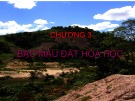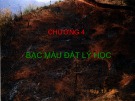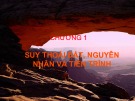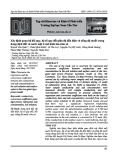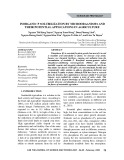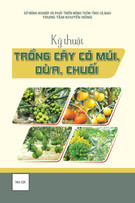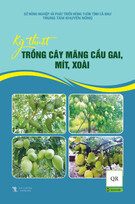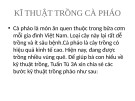
142 Nong Lam University, Ho Chi Minh City
The Journal of Agriculture and Development 23(Special issue 1) www.jad.hcmuaf.edu.vn
number of samples in row i (positive error) and
total number of samples in column i (negative
error), respectively; N - the total number of
observations.
The coefficient K < 0.40 is low accuracy,
0.41 - 0.60 is moderate accuracy; 0.61 - 0.80
is substantial accuracy, and > 0.81 is perfect
accuracy (Li, 2010).
For LULC maps, the study compared the
classification results using the MLC method and
real classification, which is examined based on
the high-resolution images from Google Earth
(Islami et al., 2022; Mehra & Swain, 2024).
The accuracy of LST maps built on remote
sensing data can be assessed by three methods:
temperature-based (T-based), radiance-based
(R-based), and cross-validation (Li et al., 2013).
Nevertheless, due to the restrictions of time and
research finance, this study could not assess the
accuracy using the three methods mentioned.
Therefore, the reliability of the LST maps is
based on the high accuracy of several published
studies (Kafy et al., 2021; Onačillová et al., 2022;
Nugraha et al., 2024).
Where, is the vector of each pixel; is the likelihood function of x belonging to class k; and are the
vector and covariance matrix of class k.
2.2.2. LST map
The LST is calculated using spectral reflectance and correction formulas depending on the image
type. The process includes six computation steps: Top of Atmospheric (TOA) spectral radiance, TOA
to Brightness Temperature conversion, NDVI, the proportion of vegetation, Emissivity, and Land
Surface Temperature. Its formula can be shown as follows (Sajib et al., 2020):
Where, 𝑥𝑥 = [𝑥𝑥1, 𝑥𝑥2, . . . , 𝑥𝑥𝑚𝑚]𝑇𝑇 is the vector of each pixel; 𝑀𝑀𝑘𝑘(𝑥𝑥) is the likelihood function 114
of x belonging to class k; 𝜇𝜇𝑘𝑘 and 𝑆𝑆𝑘𝑘 are the vector and covariance matrix of class k.115
2.2.2. LST map116
The LST is calculated using spectral reflectance and correction formulas depending on 117
the image type. The process includes six computation steps: Top of Atmospheric (TOA) 118
spectral radiance, TOA to Brightness Temperature conversion, NDVI, the proportion of 119
vegetation, Emissivity, and Land Surface Temperature. Its formula can be shown as follows 120
(Sajib et al., 2020):121
𝐿𝐿𝑆𝑆𝐿𝐿 = 𝐶𝐶2
𝜆𝜆
𝑒𝑒𝑒𝑒𝑒𝑒,𝑇𝑇𝑇𝑇𝑇𝑇10
𝐶𝐶1.𝜏𝜏𝑇𝑇𝑇𝑇𝑇𝑇10.𝐿𝐿𝐿𝐿𝐿𝐿𝑇𝑇𝑇𝑇𝑇𝑇10
5
.(𝐿𝐿𝑇𝑇𝑇𝑇𝑇𝑇10 − 𝐿𝐿𝑢𝑢𝑢𝑢 − 𝜏𝜏𝑇𝑇𝑇𝑇𝑇𝑇10(1−𝐿𝐿𝐿𝐿𝐿𝐿𝑇𝑇𝑇𝑇𝑇𝑇10).𝐿𝐿𝑑𝑑𝑑𝑑𝑑𝑑𝑑𝑑)+1
(2)122
Where, 𝜆𝜆𝑒𝑒𝑒𝑒𝑒𝑒,𝑇𝑇𝑇𝑇𝑇𝑇10 is the effective wavelength of band Thermal Infrared (TIR); 𝐿𝐿𝑇𝑇𝑇𝑇𝑇𝑇10 is the 123
Top-of-Atmosphere thermal radiance; 𝜏𝜏𝑇𝑇𝑇𝑇𝑇𝑇10 is the band TIR average atmospheric 124
transmittance; 𝐿𝐿𝑆𝑆𝐿𝐿𝑇𝑇𝑇𝑇𝑇𝑇10 is the emissivity of the band TIR; C1 and C2 are Planck’s first and 125
second radiation constants (C1 = 1.19104 x 108 W m4 m-2 sr-1 and C2 = 1.43877 x 104 m 126
K); Lup and Ldown are the upwelling and downwelling radiance in the atmosphere obtained in 127
band TIR.128
2.2.3. Map accuracy assessment129
The accuracy of the LULC maps was evaluated using the Kappa coefficient (K) 130
according to the formula 3 (Cohen, 1960). This coefficient presents the measurement of rater 131
reliability, which is computed based on the error matrix of the class identified at 500 132
randomly selected plots, which were created by Create Random Points in ArcToolbox in 133
ArcMap.134
𝐾𝐾 = 𝑁𝑁∑𝑥𝑥𝑖𝑖𝑖𝑖− ∑ (𝑥𝑥𝑖𝑖+.𝑥𝑥+𝑖𝑖)
𝑟𝑟
𝑖𝑖=1
𝑟𝑟
𝑖𝑖=1
𝑁𝑁2− ∑ (𝑥𝑥𝑖𝑖+.𝑥𝑥+𝑖𝑖)
𝑟𝑟
𝑖𝑖=1 (3)135
Where, r - the number of rows in matrix; xkk - the number of observations in row i and 136
column i respectively; xi+ and x+i - the total number of samples in row i (positive error) and 137
total number of samples in column i (negative error), respectively; N - the total number of 138
observations.139
The coefficient K < 0.40 is low accuracy, 0.41 - 0.60 is moderate accuracy; 0.61 - 0.80 140
is substantial accuracy, and > 0.81 is perfect accuracy (Li, 2010).141
Where, 𝑥𝑥 = [𝑥𝑥1, 𝑥𝑥2, . . . , 𝑥𝑥𝑚𝑚]𝑇𝑇 is the vector of each pixel; 𝑀𝑀𝑘𝑘(𝑥𝑥) is the likelihood function 114
of x belonging to class k; 𝜇𝜇𝑘𝑘 and 𝑆𝑆𝑘𝑘 are the vector and covariance matrix of class k.115
2.2.2. LST map116
The LST is calculated using spectral reflectance and correction formulas depending on 117
the image type. The process includes six computation steps: Top of Atmospheric (TOA) 118
spectral radiance, TOA to Brightness Temperature conversion, NDVI, the proportion of 119
vegetation, Emissivity, and Land Surface Temperature. Its formula can be shown as follows 120
(Sajib et al., 2020):121
𝐿𝐿𝑆𝑆𝐿𝐿 = 𝐶𝐶2
𝜆𝜆𝑒𝑒𝑒𝑒𝑒𝑒,𝑇𝑇𝑇𝑇𝑇𝑇10.𝑙𝑙𝑙𝑙( 𝐶𝐶1.𝜏𝜏𝑇𝑇𝑇𝑇𝑇𝑇10.𝐿𝐿𝐿𝐿𝐿𝐿𝑇𝑇𝑇𝑇𝑇𝑇10
𝜆𝜆𝑒𝑒𝑒𝑒𝑒𝑒
5.(𝐿𝐿𝑇𝑇𝑇𝑇𝑇𝑇10 − 𝐿𝐿𝑢𝑢𝑢𝑢 − 𝜏𝜏𝑇𝑇𝑇𝑇𝑇𝑇10(1−𝐿𝐿𝐿𝐿𝐿𝐿𝑇𝑇𝑇𝑇𝑇𝑇10).𝐿𝐿𝑑𝑑𝑑𝑑𝑑𝑑𝑑𝑑)+1 (2)122
Where, 𝜆𝜆𝑒𝑒𝑒𝑒𝑒𝑒,𝑇𝑇𝑇𝑇𝑇𝑇10 is the effective wavelength of band Thermal Infrared (TIR); 𝐿𝐿𝑇𝑇𝑇𝑇𝑇𝑇10 is the 123
Top-of-Atmosphere thermal radiance; 𝜏𝜏𝑇𝑇𝑇𝑇𝑇𝑇10 is the band TIR average atmospheric 124
transmittance; 𝐿𝐿𝑆𝑆𝐿𝐿𝑇𝑇𝑇𝑇𝑇𝑇10 is the emissivity of the band TIR; C1 and C2 are Planck’s first and 125
second radiation constants (C1 = 1.19104 x 108 W m4 m-2 sr-1 and C2 = 1.43877 x 104 m 126
K); Lup and Ldown are the upwelling and downwelling radiance in the atmosphere obtained in 127
band TIR.128
2.2.3. Map accuracy assessment129
The accuracy of the LULC maps was evaluated using the Kappa coefficient (K) 130
according to the formula 3 (Cohen, 1960). This coefficient presents the measurement of rater 131
reliability, which is computed based on the error matrix of the class identified at 500 132
randomly selected plots, which were created by Create Random Points in ArcToolbox in 133
ArcMap.134
𝐾𝐾 = 𝑁𝑁∑𝑥𝑥𝑖𝑖𝑖𝑖− ∑ (𝑥𝑥𝑖𝑖+.𝑥𝑥+𝑖𝑖)
𝑟𝑟
𝑖𝑖=1
𝑟𝑟
𝑖𝑖=1
𝑁𝑁2− ∑ (𝑥𝑥𝑖𝑖+.𝑥𝑥+𝑖𝑖)
𝑟𝑟
𝑖𝑖=1
(3)135
Where, r - the number of rows in matrix; xkk - the number of observations in row i and 136
column i respectively; xi+ and x+i - the total number of samples in row i (positive error) and 137
total number of samples in column i (negative error), respectively; N - the total number of 138
observations.139
The coefficient K < 0.40 is low accuracy, 0.41 - 0.60 is moderate accuracy; 0.61 - 0.80 140
is substantial accuracy, and > 0.81 is perfect accuracy (Li, 2010).141
96
Figure 1. The geographical location of Lac Duong district.97
Landsat 8 and 9 OLI satellite imagery data were downloaded from the United States 98
Geological Survey - USGS website. Two satellite imageries (124/051 and 124/052) captured 99
in May 2013 and in March 2015, 2017, 2019, 2021, and 2023 are used to build LULC and 100
LST maps in this study. The satellite imageries meet cloudy conditions (< 10%) and have a 101
spatial resolution of 30 x 30 m.102
2.2. LULC and LST maps103
2.2.1. LULC map104
This study classifies land use and land cover into five types: Forest land, Crop land, 105
Built-up land, Bare land, and Water body. LULC maps are constructed from satellite image 106
data sources combined with a supervised classification method - Maximum Likelihood 107
Classification (MLC) algorithm. The MLC method constructs probability density functions 108
for each class. Each class is characterized by two features including mean vector and 109
covariance matrix, from which the statistical likelihood is calculated for each class. The 110
algorithm will then identify each remaining pixel and will be assigned to the class that it is 111
most likely to be a member of according to the Bayesian formula (Sun et al., 2013).112
𝑀𝑀𝑘𝑘(𝑥𝑥)=ln P( 𝐺𝐺𝑘𝑘) + ln |𝑆𝑆𝑘𝑘
−1|1/2
2𝜋𝜋𝑚𝑚/2 − 1
2(𝑥𝑥 − 𝜇𝜇𝑘𝑘)𝑇𝑇𝑆𝑆𝑘𝑘
−1(𝑥𝑥 − 𝜇𝜇𝑘𝑘) (1)113
(1)
(2)
Where, is the effective wavelength of
band Thermal Infrared (TIR); is the Top-of-
Atmosphere thermal radiance; is the band
TIR average atmospheric transmittance; is
the emissivity of the band TIR; C1 and C2 are
Planck’s first and second radiation constants (C1
= 1.19104 x 108 W mm4 m-2 sr-1 and C2 = 1.43877
x 104 mm K); Lup and Ldown are the upwelling
and downwelling radiance in the atmosphere
obtained in band TIR.
2.2.3. Map accuracy assessment
The accuracy of the LULC maps was evaluated
using the Kappa coefficient (K) according to
the formula 3 (Cohen, 1960). This coefficient
presents the measurement of rater reliability,
which is computed based on the error matrix
of the class identified at 500 randomly selected
plots, which were created by Create Random
Points in ArcToolbox in ArcMap.
Where, r - the number of rows in matrix;
xkk - the number of observations in row i and
column i respectively; xi+ and x+i - the total
(3)










